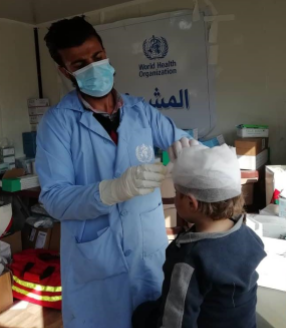 A WHO-supported medical team provides trauma care services to injured children in Al Hol camp
A WHO-supported medical team provides trauma care services to injured children in Al Hol camp
- During the reporting period, 68 080 inhabitants continued to seek shelter in a camp originally designed to house only 10 000 people.
- The volatile security situation in northern-east Syria is negatively impacting operations requiring coordination, such as referral mechanisms and the provision of health services. This forces patients requiring treatment to wait for longer periods of time before receiving treatment.
- The total number of available health services in the camp are: 15 static medical points, 8 medical mobile teams, 3 delivery clinics, 2 HIV and TB clinics, 3 field hospitals, one static point for vaccinations, one static point for leishmaniasis, and one mobile medcial team.
- The referral system is ongoing and patients are referred to the WHO-supported Al-Hikmah private hospital in AlHassakeh governorate which receives only emergency cases.
- Phase 8 remains a challenge with more than 5 security incidents occurring and affecting operations by health actors. Insecurity has also affected the TCN Annex, with the only health point at the Annex entrance suspended, and mobile teams facing staff shortages. There are no ambulances in the annex .The health sector is discussing a new modality to engage paramedics with stretchers to carry patients out to the gate area where the ambulance is available. TCN inhabitants expressed their anger at the lack of services by attacking mobile health workers stationed inside the annex. As a result, all health partners agreed to enter the Annex in one convoy to avoid further violent incidents against health workers.
- The provision of health services in the three field hospitals was relatively affected, especially in the provision of major and specialized surgeries; however, the three field hospitals continued to admit and treat new patients who require basic and essential surgical interventions such as open fractures, wound cleaning and sterilizing, normal and caesarian deliveries, in addition to abdominal and chest trauma. Other essential health services not available at the hospitals need to be referred outside the camp, including major surgeries cholecystectomies, burns treatment, malnutrition and ophthalmology. Although the referral mechanism was affected by the latest security incidents, the emergency mechanism (including children with severe acute malnutrition) is being smoothly implemented.
- The Disease Early Warning and Response System (EWARS) reported with an average of 91.7% and 100% timeliness. This decrease in reporting response is related to the lack of health teams in charge of submitting the required data. However, the most common morbidity cases are related to acute diarrhoea, influenza-like illnesses, severe acute respiratory infections, chickenpox, measles scabies and lice.
- During the reporting period, there was one suspected measles case. A blood sample was collected and sent to the central laboratory in Damascus for confirmation. No suspected acute flaccid paralysis or tuberculosis cases were reported.
Al Hol Camp situation report, Issue 17, 25 October–7 December 2019
Situation reports
Al Hol Camp situation report, Issue 16, 27 September–24 October 2019
Al Hol Camp situation report, Issue 15, 30 August–26 September 2019
Al Hol Camp situation report, Issue 14, 16–29 August 2019
Al Hol Camp situation report, Issue 13, 2–15 August 2019
Al Hol Camp situation report, Issue 12, 19 July–1 August 2019
Al Hol Camp situation report, Issue 11, 5–18 July 2019
Al Hol Camp situation report, Issue 10, 22 June–4 July 2019
Al Hol Camp situation report, Issue 9, 22 June–4 July 2019
Al Hol Camp situation report, Issue 8, 25 May–7 June 2019
Al Hol Camp situation report, Issue 7, 12–24 May 2019
Al Hol Camp situation report, Issue 6, 26 April–11 May 2019
Al Hol Camp situation report, Issue 5, 12–25 April 2019
Al Hol Camp situation report, Issue 4, 29 March–11 April 2019
Al Hol Camp situation report, Issue 3, 15–27 March 2019
Al Hol Camp situation report, Issue 2, 25 February–14 March 2019
Al Hol Camp situation report, Issue 1, February 2019
EWARS bulletins
2020
EWARS Weekly Epidemiological Bulletin, Week 1
EWARS Weekly Epidemiological Bulletin, Week 2
EWARS Weekly Epidemiological Bulletin, Week 3
2019
EWARS Weekly Epidemiological Bulletin, Week 52
EWARS Weekly Epidemiological Bulletin, Week 51
EWARS Weekly Epidemiological Bulletin, Week 50
EWARS Weekly Epidemiological Bulletin, Week 49
EWARS Weekly Epidemiological Bulletin, Week 48
EWARS Weekly Epidemiological Bulletin, Week 47
EWARS Weekly Epidemiological Bulletin, Week 46
EWARS Weekly Epidemiological Bulletin, Week 45
EWARS Weekly Epidemiological Bulletin, Week 44
EWARS Weekly Epidemiological Bulletin, Week 43
EWARS Weekly Epidemiological Bulletin, Week 42
EWARS Weekly Epidemiological Bulletin, Week 41
EWARS Weekly Epidemiological Bulletin, Week 40
EWARS Weekly Epidemiological Bulletin, Week 39
EWARS Weekly Epidemiological Bulletin, Week 38
EWARS Weekly Epidemiological Bulletin, Week 37
EWARS Weekly Epidemiological Bulletin, Week 36
EWARS Weekly Epidemiological Bulletin, Week 35
EWARS Weekly Epidemiological Bulletin, Week 34
EWARS Weekly Epidemiological Bulletin, Week 33
EWARS Weekly Epidemiological Bulletin, Week 28
EWARS Weekly Epidemiological Bulletin, Week 27
EWARS Weekly Epidemiological Bulletin, Week 25
EWARS Weekly Epidemiological Bulletin, Week 24
EWARS Weekly Epidemiological Bulletin, Week 23
EWARS Weekly Epidemiological Bulletin, Week 22
EWARS Weekly Epidemiological Bulletin, Week 21
EWARS Weekly Epidemiological Bulletin, Week 20
EWARS Weekly Epidemiological Bulletin, Week 19
EWARS Weekly Epidemiological Bulletin, Week 18
EWARS Weekly Epidemiological Bulletin, Week 17
EWARS Weekly Epidemiological Bulletin, Week 16
EWARS Weekly Epidemiological Bulletin, Week 15
EWARS Weekly Epidemiological Bulletin, 31 March–6 April 2019








